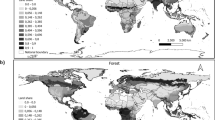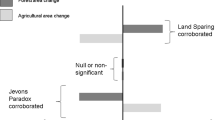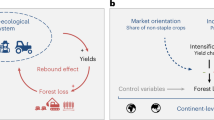Abstract
Expansion of agriculture is a main cause of tropical deforestation. Government policies and weak property rights contribute to this process by encouraging landowners and landless to accelerate land clearing. Using panel data common to previous studies, we add the dimension of new political regimes, democratic and non-democratic, and investigate how the rate of agricultural land expansion in tropical countries depends on the nature and persistence of each regime. We find that both new autocratic and democratic regimes have accelerated the expansion of agricultural land, thus yielding support to some of the findings in the earlier literature. Interesting differences emerge between regions, with the impact being most pronounced in Latin America. We interpret these results mainly in the context of increasing tenure and ownership insecurity, which in turn is driven by the tendency of new regimes to implement land reforms as a form of social and economic policy or voter payback. The argument is developed more formally using a simple competitive land use model that incorporates political regime dependent confiscation risk and agricultural subsidy policy.
Similar content being viewed by others
Notes
These reforms have been varying in their scale and scope, and in underlying intentions. Some have included direct expropriation and redistribution of private land, whereas others have aimed at encouraging peasants to colonize frontier lands. Adams (1995) observes that many historical land reforms in tropical countries have been purely opportunistic in their motives.
In our model, political regimes exert effort to stay in power. This in turn may have an influence on the relative land rents from agriculture and forests. Since the direction of change in land rents is a priori unknown, we propose an econometric model that is closely linked to our analytical model to estimate and test this relationship based on historical data on land use.
These mostly modest land reforms have been carried out with the support of the landowning class in the hopes of preventing subsequent more severe infringement of their land holdings (Adams 1995).
Pfaff (1999) describes how in Brazil the military regime’s push to colonize the Amazonian Basin in the 1970s was related to their effort to reduce pressures for social unrest due to growing population.
Binswanger (1991) and Alston et al. (2000) provide evidence that such land policies in Brazil have contributed to deforestation through conflicting interests and land clearing incentives. The landowners expelled tenants and embarked on expanding extensive ranching activities after learning about land reform plans (Deininger and Binswanger 1999). In Cameroon the expectations of the 1974 land reform, where the government was planning to confiscate parts of the community forests for commercial exploitation, led villagers to rapidly expand croplands in order to establish ownership claim (Karsenty 2010).
Bohn and Deacon (2000) also employ a similar type of an approach to identify the political factors influencing the investment environment. Their data on political attributes, however, come from a different source and the results with respect to deforestation are based on a limited cross-section study.
Barbier (2001) and Barbier and Burgess (2001) recommend using agriculture land data because of problems with the reliability of existing forest cover data. Remote sensing data have recently become more readily available for some tropical countries, but these data are still too limited for the purpose of this study.
Alston et al. (2000) explain how Brazilian land policies create incentives for both landowners and squatters to clear rainforests for pasture. They find that land reform programs have been responsible for 30 percent of deforestation, or approximately 15 million hectares, between 1964 and 1997.
Deacon (1994) identifies cronyism and the inability of governments to enforce property rights as the two main factors feeding political uncertainty, which in turn deteriorates the profitability of long term investments. Bohn and Deacon (2000) provide evidence that political instability decreases investment share of total output, thus implying a reduction in forest capital as well.
It is also possible that higher benefits attract more competition for power and thus the likelihood of regime change may actually increase. We could model this feature by making the cost of exacting effort to depend on variable \(B\) with higher benefits increasing the cost of effort. The interpretation would be that higher benefits translate to fiercer competition as the quality and number of political opponents increases, and thus increases the cost of effort.
More precisely, regime effort influences the relative land rents from both agriculture and forests. Therefore, we could in principle have the effort variable entering both the agricultural rent and the forest rent functions. The current notation simplifies the interpretation of the results.
This assumption undoubtedly simplifies the complex and region specific process of deforestation, but we can justify it on two grounds. First, it enables us to focus on our main argument that new regimes have a more active stance vis-à-vis land reforms, which in turn has an impact on the expansion of agricultural frontier in the tropics. Secondly, our specification does allow our goal of capturing the impact of political regime across different countries with varying land-uses, such as intensive agriculture, shifting cultivation, cattle ranching, plantation forestry, and timber concessions, while controlling for those variables known to be important to deforestation from previous work. Plantation forests are not necessarily a substitute for native forests or even for degraded forest stands. The real definition of deforestation is therefore more nuanced and contested than the one we apply here. Notice, however, that our main goal is to assess the impact of new regimes on agricultural expansion.
This is a common assumption made in the economic analysis of land-use decisions. The same approach has been used extensively in the past work on tropical deforestation (e.g. Mendelsohn 1994; Deacon 1994; Chomitz and Gray 1996; Angelsen and Kaimowitz 1999; Pfaff 1999; Angelsen 2007; Amacher et al. 2008, 2009).
This allows us to test for the Environmental Kuznets Curve hypothesis, the presence of a turning point for deforestation-income relationship.
López and Galinato (2005a, b) and Galinato and Galinato (2011) postulate a structural model where road building and crop area, the direct causes of deforestation, are simultaneously determined. They then estimate the contribution of each indirect source of deforestation to the direct causes. The focus of our study is to determine the effect of a regime change on agricultural land expansion and this effect can be through road building, subsidies, or confiscation risk.
The advantage of fixed effects model is that we are able to control for unobserved individual effects that may bias coefficient estimates in cross-sectional studies if they are correlated with independent variables.
We have removed observations with zero values. To check for potential selection problem, we estimate a Heckman selection model and cannot reject random selection. We have also removed observations that have exceptionally large values (the lower and upper \(1\)st percentiles).
See “Appendix 2” for the list of countries.
Information on road building is also an important missing element (López and Galinato 2005a). Data on roads is again limited and would not allow construction of a large enough sample.
Ferreira and Vincent (2010) use Political Risk Services’ governance indices that cover years 1984–2006 to estimate the effect of governance on timber harvests. The within variation of such index measures is small, and considering the ordinal nature of such variables together with the short time span covered, we choose time-averaged values instead. It is of course possible that the institutional conditions have developed in a given country and that these developments in turn get confounded with our political regime effects. On the other hand, political regime changes may provide impetus for institutional improvements or deterioration. These effects may therefore be hard to identify jointly with available data.
We assume here that the preceding 2 years are enough to capture the expectations of a regime change and any uncertainty caused by a prospective land reform.
For example, a revolution could sweep in during 1 year or it could require a prolonged civil war before any clear outcome is perceivable. In many cases, the outcome is actually muddled where the new regime lies somewhere in between the two regime types. In encoding the indicator variables, we have followed the definitions provided by Polity IV in a consistent manner in order reduce ambiguities.
Cluster robust standard errors allow for both within heterogeneity and serial correlation.
We use a Wald test to determine whether differences in slopes are significant.
Dynamic IV and GMM estimates for the lagged dependent variable did not differ much from the within estimate.
We also tried including interaction terms with other control variables but these were deemed as not important.
Barbier (2001) finds that a general political stability indicator variable is a significant and positive predictor of agricultural land expansion in Latin America. Our interpretation goes further in showing that political regime is important, and as such the results for Latin American countries are best in line with our initial predictions.
This interpretation is in line with the literature on rent-seeking elites and resource curse which tend to invite civil war and armed conflict especially in resource rich countries (Ross 1999; Addison et al. 2002). In terms of our theory model, new regimes exert effort to stay in power through war and factional fighting, and also through distributing resource rents to their supporters.
Furthermore, traditional forms of land ownership, such as community lands and forests, have persisted in the face of attempts to reform land titling systems (Platteau 2000). They continue to be a prevalent form of de facto land use right even though community lands may still lack a judicial recognition.
This policy is cited as responsible for gaining wide support of the population for the ruling regime. Land expropriations, however, targeted mainly Marcos’s political enemies such as the communist movement (Borras Jr. 2001).
References
Acemoglu D, Robinson JA (2001) A theory of political transitions. Am Econ Rev 91(4):938–963
Adams M (1995) Land reform: new seeds on old ground? Overseas Development Institute, London
Addison T, Le Billon P, Murshed SM (2002) Conflict in Africa: the cost of peaceful behaviour. J Afr Econ 11(3):365–386
Alston LJ, Libecap GD, Mueller B (2000) Land reform policies, the sources of violent conflict, and implications for deforestation in the Brazilian Amazon. J Environ Econ Manag 39:162–188
Amacher GS, Koskela E, Ollikainen M (2008) Deforestation and land use under insecure property rights. Environ Dev Econ 14(3):281–303
Amacher GS, Koskela E, Ollikainen M (2009) Economics of forest resources. MIT Press, Cambridge
Anderson TW, Hsiao C (1982) Formulation and estimation of dynamic models using panel data. J Econom 18:47–82
Angelsen A (2007) Forest cover change in space and time: combining the von Thunen and forest transition theories. World Bank Policy Research Working Paper No. 4117
Angelsen A, Kaimowitz D (1999) Rethinking the causes of deforestation: lessons from economic models. World Bank Res Obs 14(1):73–98
Arellano M, Bond S (1991) Some tests of specification for panel data: Monte Carlo evidence and an application to employment equations. Rev Econ Stud 58(2):277–297
Barbier EB (2001) The economics of tropical deforestation and land use: an introduction to the special issue. Land Econ 77(2):155–171
Barbier EB (2004) Explaining agricultural land expansion and deforestation in developing countries. Am J Agric Econ 86(5):1347–1353
Barbier EB (2011) Scarcity and frontiers: how economies have developed through natural resource exploitation. Cambridge University Press, New York
Barbier EB, Burgess JC (1997) The economics of tropical forest land use options. Land Econ 73(2):174–195
Barbier EB, Burgess JC (2001) The economics of tropical deforestation. J Econ Surv 15(3):413–433
Berry RA, Cline WR (1979) Agrarian structure and productivity in developing countries. Johns Hopkins Univ. Press, Baltimore
Binswanger HP (1991) Brazilian policies that encourage deforestation in the amazon. World Dev 19(7): 821–829
Bohn H, Deacon RT (2000) Ownership risk, investment, and the use of natural resources. Am Econ Rev 90(3):526–549
Borras SM Jr (2001) State-society relations in land reform implementation in the Philippines. Dev Chang 32:545–575
Brockett CD (1990) Land, power, and poverty: agrarian transformation and political conflict in Central America. Unwin Hyman, Sydney
Brooker P (2009) Non-democratic regimes, 2nd edn. Palgrave Macmillan, New York
Buitenzorgy M, Mol APJ (2011) Does democratization lead to a better environment? Deforestation and democratic transition peak. J Environ Res Econ 48:59–70
Chomitz KM, Buys P, De Luca G, Thomas TS, Wertz-Kanounnikoff S (2007) At loggerheads? Aricultural expansion, poverty reduction, and environment in the tropical forests. World Bank Report
Chomitz KM, Gray DA (1996) Roads, land use, and deforestation: a spatial model applied to Belize. World Bank Econ Rev 10(3):487–512
Daley E, Hobley M (2005) Land: changing contexts, changing relationships, changing rights. Urban-Rural Change Team (DFID)
De Janvry A (1981) The role of land reform in economic development: policies and politics. Am J Agric Econ 63(2):384–392
Deacon RT (1994) Deforestation and the rule of law in a cross-section of countries. Land Econ 70(4):414–430
Deacon RT (1995) Assessing the relationship between government policy and deforestation. J Env Econ Man 28(1):1–18
Deacon RT (1999) Deforestation and ownership: evidence from historical accounts and contemporary data. Land Econ 75(3):341–359
Deininger KW (2003) Land policies for growth and poverty reduction. World Bank Publications, Washington
Deininger K, Binswanger HP (1999) The evolution of the world bank’s land policy: principles, experience, and future challenges. World Bank Res Obs 14(2):247–276
Ferreira S, Vincent JR (2010) Governance and timber harvests. Environ Res Econ 47(2):241–260
Galinato GI, Galinato SP (2011) The effects of corruption control, political stability and economic growth on deforestation induced carbon dioxide emissions. Environ Dev Econ 17(1):67–90
Grossman HI (1994) Production, appropriation, and land reform. Am Econ Rev 84(3):705–712
Jensen N, Wantchekon L (2004) Resource wealth and political regimes in Africa. Comp Polit Stud 37(7): 816–841
Karsenty A (2010) Large-scale acquisition of rights on forest lands in Africa. Rights and Resources Initiative, Washington
Laporte A, Windmeijer F (2005) Estimation of panel data models with binary indicators when treatment effects are not contant over time. Econ Lett 88:389–396
López R, Galinato GI (2005a) Deforestation and forest-induced carbon dioxide emissions in tropical countries: how do governance and trade openness affect the forest-income relationship? J Environ Dev 14(1):73–100
López R, Galinato GI (2005b) Trade policies, economic growth, and the direct causes of deforestation. Land Econ 81(2):145–169
Marshall MG, Gurr TR, Jaggers K (2010) Polity IV project: political regime characteristics and transitions, 1800–2009. Center for Systemic Peace, Vienna
Mendelsohn R (1994) Property rights and tropical deforestation. Oxf Econ Pap 46:750–756
Midlarsky MI (1998) Democracy and the environment: an empirical assessment. J Peace Res 35(3):341–361
Nickell S (1981) Biases in dynamic models with fixed effects. Econometrica 49(6):1417–1426
Pfaff A (1999) What drives tropical deforestation in the Brazilian Amazon. J Environ Econ Manag 37:26–43
Pfaff A, Sills EO, Amacher GS et al (2010) Policy impacts on deforestation: lessons learned from past experiences to inform new initiatives. Duke University Press, Durham
Platteau JP (2000) Allocating and enforcing property rights in land: informal versus formal mechanisms in Subsaharan Africa. Nord J Pol Econ 26(1):55–81
Prosterman RL, Riedinger JM (1987) Land reform and democratic development. The John Hopkins University Press, Baltimore
Rodrik D, Wacziarg R (2005) Do democratic transitions produce bad economic outcomes? Am Econ Rev 95(2):50–55
Ross ML (1999) The political economy of the resource curse. World Polit 51(2):297–322
Ross ML (2001) Timber booms and institutional breakdown in Southeast Asia. Cambridge University Press, Cambridge
Author information
Authors and Affiliations
Corresponding author
Additional information
This paper is based on a chapter from Kuusela’s dissertation.
Appendices
Appendix 1
The Bellman equation is
The first-order condition in regime \(i\) is
where \(V_{1} \) denotes the derivative of the value function with respect to the first argument. By Envelope theorem:
Combining the above two, we get
Forwarding this by one period for regime state \(i\)
and for regime state \(j\)
Rearranging:
Substitute these back to the original FOC:
Rearranging:
Noticing that \(p_{ii} +p_{ij} =1\), we get:
Finally, using the expectation operator, we can simplify the above expression to yield Eq. (6):
Appendix 2: Countries
Angola, Belize, Benin, Bolivia, Botswana, Brazil, Burkina Faso, Burundi, Cambodia, Cameroon, Central African Republic, Chad, Colombia, Comoros, Dem. Rep. Congo, Rep. Congo, Costa Rica, Cote d’Ivoire, Djibouti, Dominican Republic, Ecuador, El Salvador, Ethiopia, Fiji, Gabon, Gambia, Ghana, Guatemala, Guinea, Guyana, Haiti, Honduras, India, Indonesia, Jamaica, Kenya, Liberia, Madagascar, Malawi, Malaysia, Mali, Mauritania, Mauritius, Mexico, Mozambique, Nicaragua, Niger, Nigeria, Panama, Papua New Guinea, Peru, Philippines, Rwanda, Senegal, Sierra Leone, Sri Lanka, Sudan, Tanzania, Thailand, Togo, Uganda, Venezuela, Vietnam, Rep. Yemen, Zambia, Zimbabwe.
Rights and permissions
About this article
Cite this article
Kuusela, OP., Amacher, G.S. Changing Political Regimes and Tropical Deforestation. Environ Resource Econ 64, 445–463 (2016). https://doi.org/10.1007/s10640-015-9880-6
Accepted:
Published:
Issue Date:
DOI: https://doi.org/10.1007/s10640-015-9880-6




